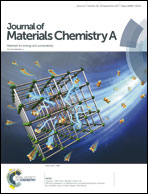Inorganic adhesives for robust, self-healing, superhydrophobic surfaces†
Abstract
Superhydrophobic surfaces demonstrate remarkable advantages involving interfacial issues but limited practical applications due to their poor mechanical robustness and environmental durability. The required micro-/nano-hierarchical structures and low-surface-energy nanocomponents are very vulnerable to physical and chemical destruction. Moreover, harsh conditions fundamentally weaken the mechanical strength of already-constructed robust superhydrophobic surfaces. In this work, inorganic adhesives are proposed to strengthen the bonding force between superhydrophobic coatings and various substrates. A simple spray-coating method is adopted to fabricate superhydrophobic surfaces using an all-in-one suspension that contains an aluminum phosphate binder, titanium dioxide nanoparticles, and alkylsilane. The surfaces benefitting from inorganic adhesives still extremely repel water after physical abrasion, and greatly endure harsh conditions including hot oil (80 °C), hot water (80 °C), and hot acetone (50 °C) for 24 h to preserve their high mechanical strength. The prepared coatings also have a self-healing ability against boiling-water treatment, O2-plasma etching, and amphiphilic pollution. Superhydrophobicity can be rapidly regenerated after multiple cycles of high-temperature repairing for 5 min. In addition, the robust interfacial materials exhibit a very reliable performance in oil–water separation after 100 abrasion cycles. Benefiting from the distinctive advantages of inorganic adhesives, interfacial materials will be broadly developed for practical applications in related fields.



 Please wait while we load your content...
Please wait while we load your content...